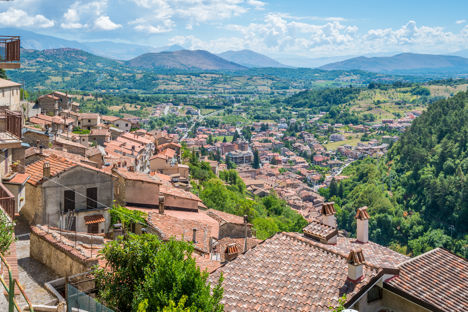
The complete foodie guide to Abruzzo
With the Apennine Mountains to the west and the Adriatic Sea to the east, Abruzzo is one of Italy’s most stunning regions. Still wild and unspoilt, its fantastic food reflects the simple agricultural practices that have shaped the area. Get to know more about this very pretty part of Italy.
The complete foodie guide to Abruzzo
With the Apennine Mountains to the west and the Adriatic Sea to the east, Abruzzo is one of Italy’s most stunning regions. Still wild and unspoilt, its fantastic food reflects the simple agricultural practices that have shaped the area. Get to know more about this very pretty part of Italy.
Almost half of Abruzzo is either a national park or a nature reserve, which helps paint a picture of just how untouched this part of Italy is. Whilst it is located in the centre of the country, most Italians see Abruzzo as part of southern Italy, and that is certainly reflected in its cuisine, which is often simple, traditional and makes the most of humble ingredients. Bordered by Le Marche to the north, Lazio to the west and Molise (which was part of Abruzzo until the 1970s) to the south, the region is split into four provinces: L’Aquila (the capital, which was hit by an earthquake in 2009); Teramo (famous for olive oil); Pescara and Chieti.
Abruzzo’s motto is ‘forte e gentile’ (strong and gentle), which is said to represent the people (known as Abruzzese) and the landscape. When it comes to the cuisine, the most iconic elements are the abundance of lamb and the use of chillies (dried or fresh, depending on the time of year) as a seasoning. But there’s much more to discover if you’re ever in the area – get to know the ingredients, produce, wines and famous dishes of the region and become an expert in the local cuisine.
Ingredients and flavours
In Abruzzo the meat most consumed is lamb, as the mountainous parts of the region are full of sheep that lazily graze the wild meadows and pastures of the area. Many of Abruzzo’s most iconic dishes feature lamb, which is grilled, braised, roasted, fried and made into sauces for pasta.
Lamb is eaten with abandon further inland, but on the Abruzzese coast fish makes up the majority of the diet. Anchovies from Vasto are held in high regard, and all sorts of fresh fish and seafood are made into soupy stews, often flavoured with plenty of local white wine. Salt cod is also a popular ingredient, and along Abruzzo’s shores you’ll find traboccho; wooden pier-like structures with little shacks on the end. These unique buildings are traditionally used to fish from, and you'll usually find restaurants nearby that serve up simple, rustic, traditional seafood dishes to the locals.
Many Italians might sprinkle grated cheese over their food just before eating, but in Abruzzo they’re just as likely to scatter chilli flakes, drizzle chilli oil or even snip thin slices of fresh chilli over the top instead. The Abruzzese love the warmth of chilli and diavolino – the local variety – can often be seen hung up outside doorways to dry.
It might not produce much of it, but the eight hectares of Abruzzo dedicated to saffron farming is famous throughout Italy. That’s because the flowers’ stems are picked by hand and gently toasted over an open fire, resulting in some of the highest quality saffron in the world. It used to be produced on a much larger scale, with the strands making their way to the richest families in Italy, who loved turning their food a golden colour with it as a show of wealth. Today, it can be bought in L’Aquila and the surrounding towns.
The Abruzzese have a longstanding tradition of making their own liqueurs and amari, filling bottles of alcohol with local ingredients to create a variety of digestifs. Many are very bitter and full of wild herbs, giving them a verdant green colour and strong taste, but there are also specialities like nocino, a green walnut liqueur.
The wines of Abruzzo are also famous, particularly Montepulciano d’Abruzzo, arguably the region’s most well-known. It’s also responsible for the amazing white wine Trebbiano d’Abruzzo, and the lesser-known Cerasuolo d’Abruzzo, a deep cherry-red rosé.
Abruzzo’s Teramo province has a reputation for producing some of the best olive oil in the whole country, and there’s even an olive oil museum in Loreto Aprutino, which is known for producing DOC-protected oil so good it’s called ‘liquid gold’. It’s often used to dress local dishes, or infused with the local chillies to create a distinctly Abruzzese product.
Along with Calabria to the south, Abruzzo is famous for liquorice, with records of liquorice production dating back to Roman times. The towns of Atri and Silvi in Teramo province are where you’ll find the most liquorice, often turned into a variety of sweets or sold in their natural stick form.
Famous dishes
These skewers of local lamb seasoned with nothing more than salt, pepper, olive oil and a little rosemary are cooked over special barbecues until just cooked and incredibly tender. They’re often served with pickles and a glass of local wine, making them the perfect al fresco feast at the height of the Italian summer.
A dish often cooked for Easter celebrations, this simple preparation of lamb braised in white wine is finished with a sauce of beaten egg and Pecorino cheese. The egg mixture is added right at the last minute, warmed through until just slightly set, then presented to the table. It uses a similar method to carbonara sauce, but with lamb instead of pasta and guanciale (cured pork cheek).
Abruzzo is home to some of the best durum wheat in Italy, which is turned into dried pasta of all shapes and sizes. But the most famous local pasta is fresh, made with eggs and requires a special instrument to create it. Pasta alla chitarra roughly translates to ‘pasta of the guitar’, and was supposedly created when a chef passed sheets of fresh pasta through the strings of a guitar (or similar instrument). The result was something similar to tagliatelle, but more robust and firm. It’s often served with a lamb and pepper ragù.
Lamb is ubiquitous throughout Abruzzo’s inland mountainous areas, but the region’s coastline means there’s plenty of fish on the menu too. Vasto, on the southern coast, is famous for its anchovies, and this simple anchovy frittata is a celebration of the local delicacy. Fresh anchovies are combined with beaten eggs, chilli flakes and pecorino cheese, then gently fried until set.
This very traditional Abruzzese dish is a simple combination of wafer-thin crêpes and a clear chicken broth with plenty of cheese grated over the top. Its origins are unclear, but it has been a favourite in the region for decades. As with any simple traditional dish, the secret lies in the quality of ingredients, so it’s certainly worth making your own stock to ensure it has the right depth of flavour.
One of Italy’s most famous traditional sweets first created in the fifteenth century, these pretty sugared almonds come in an array of colours and flavours and are often fashioned into flowers. The town of Sulmona is full of shops selling the local delicacy, and across the whole country little bags of them are often given at weddings, baptisms and anniversaries. The perfect souvenir when visiting Abruzzo.
Abruzzo’s most famous antipasto come from Chieti, a town in the centre of Abruzzo. Slices of bread are dredged in egg and fried until crunchy and golden, then simply topped with anchovy fillets and capers. They’re incredibly addictive and beautifully crisp, making them the most popular part of an antipasti spread.
Despite growing some of the highest quality saffron in the world, Abruzzo’s traditional cuisine doesn’t contain much of it at all – probably because only the very wealthy could afford to use it in cooking. There is one dish however that makes the most of the spice’s heady, fragrant flavour – scapece di Vasto. From Abruzzo’s south coast, this fish dish involves taking a whole variety of shellfish and white fish (whatever’s been caught that day), dusting them in flour and frying until crisp and cooked through. The fried fish is then layered into a deep dish and drenched in white wine vinegar infused with saffron and plenty of the local white wine, Trebbiano. It’s left to marinate for around a week before being served with bread and good olive oil.
These jam-filled pastries are often baked to celebrate whenever the harvest comes in, and local bakers use Abruzzo’s famous wheat and olive oil to create the shortcrust pastry. They’re filled with a local grape jam, made with the same grapes that go into the region’s Montepulciano wine, often accentuated with lemon zest, cinnamon, chocolate or almonds. It’s common to add a dash of a local liqueur into the mixture as well.

